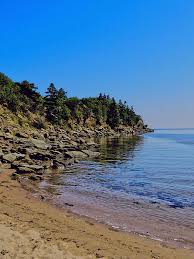
Seaweed in the Garden?!!
While chatting with a friend the other day, the subject of seaweed came up. Living in the eastern foothills of the Rocky Mountains, seaweed does not come up in conversation very often! It reminded me of growing up in New Brunswick and the semi annual trip to the beach to collect seaweed for use in the garden.
More to the point of our story though.
My friend has a friend who has some seaweed become a temporary rodent restaurant. It could no longer used for its intended purpose, and rather than send it to the landfill, they figured it could be used in the garden. The question was more if it should be composted first, or added directly to the garden. When that should happen, and should it be tilled into the soil or not?

Using seaweed in the garden has many benefits actually.
Use it as a mulch
A 4-6 inch layer (10-15 cm) of seaweed will suppress unwanted plant growth, and aid the soil in retaining moisture. Slugs, snails, and other pests do not like the salty, sharp edges of seaweed. Seaweed does not dry out in the same fashion as other forms of mulch making it less of a fuel source for sparks. If you live in an area prone to dangerous fire threat conditions, seaweed may be an alternative ground cover mulch.
Feed the soil
Seaweed is full of nutrients and minerals that aid in other plant growth. Nitrogen, Magnesium, Potassium to name a few. There are also a host of micronutrients in seaweed that will become available as the ground cover decomposes. Something you do not get with bark mulch. Seaweed will also aerate the soil, and deter some fungi and diseases as it adds all those nutrients to the soil. If seaweed is added around the same time as some brown mulch, say leaf litter, the nitrogen in the seaweed is balanced by the carbon in the leaf litter.
Put it in your compost
The local variety and quantity of seaweed available will dictate how best to use seaweed in the garden. Kelp, Dulce, Rock-weed, and other forms all have different consistencies and some are better suited for mulch. Others, are more algae than vine, and are better suited for composting. The more algae varieties can still be used as mulch. They will breakdown faster, and require more volume to get the same coverage as a mulch.
Put it in your Tea!

Adding kelp or seaweed to your compost tea will help feed the beneficial microorganisms both in the tea, and in the soil. I use a kelp extract in the teas I brew. It is easier to find around here than the raw product. If you have actual seaweed, you can add a couple of handfuls to the tea to get a lot of the nutrients out during the brewing process.
Special note on collecting seaweed
Be respectful of the ecosystem. Only take what you need. Only take when there is an abundance around. Do not take it all from one area if you can. The beaches and the creatures in that ecosystem also need the seaweed. Always check that where you are going to collect from is not a protected area of some kind. Many localities are protecting their beach habitats and have placed certain rules and regulations on the collecting of anything off the beach.

